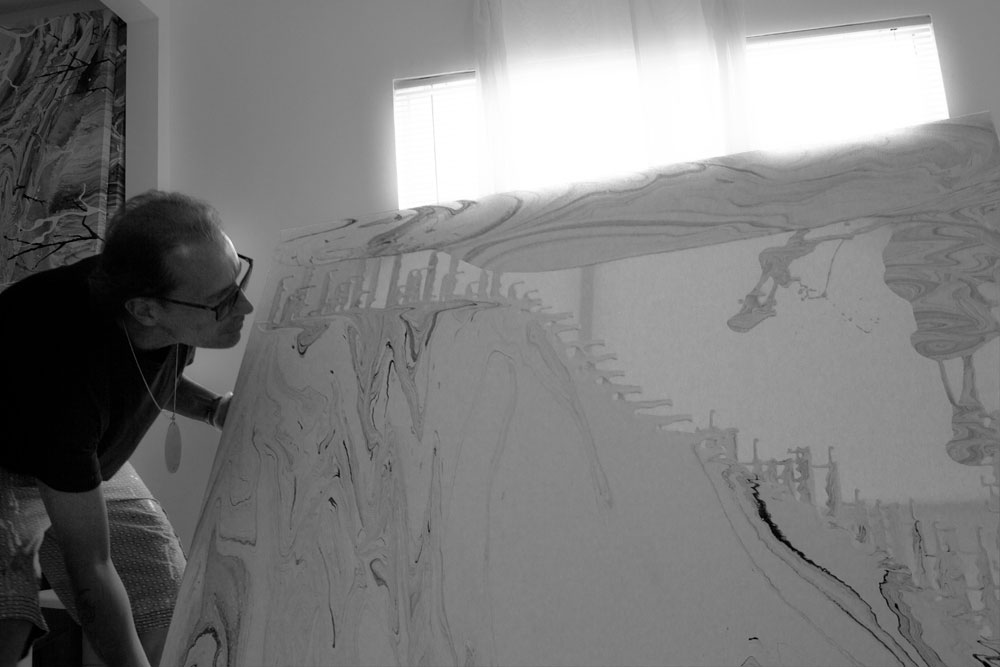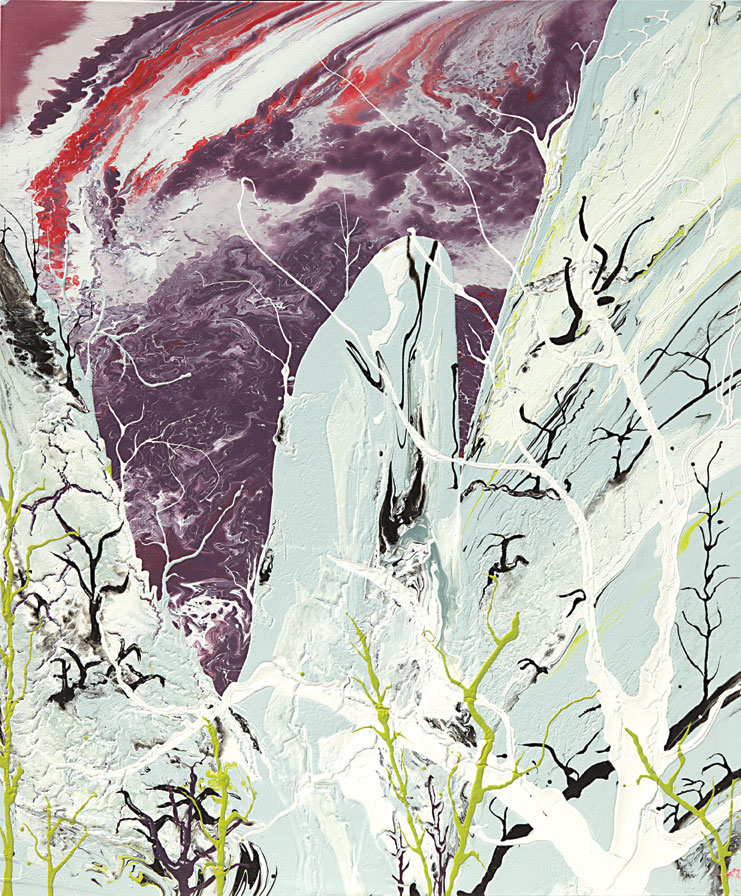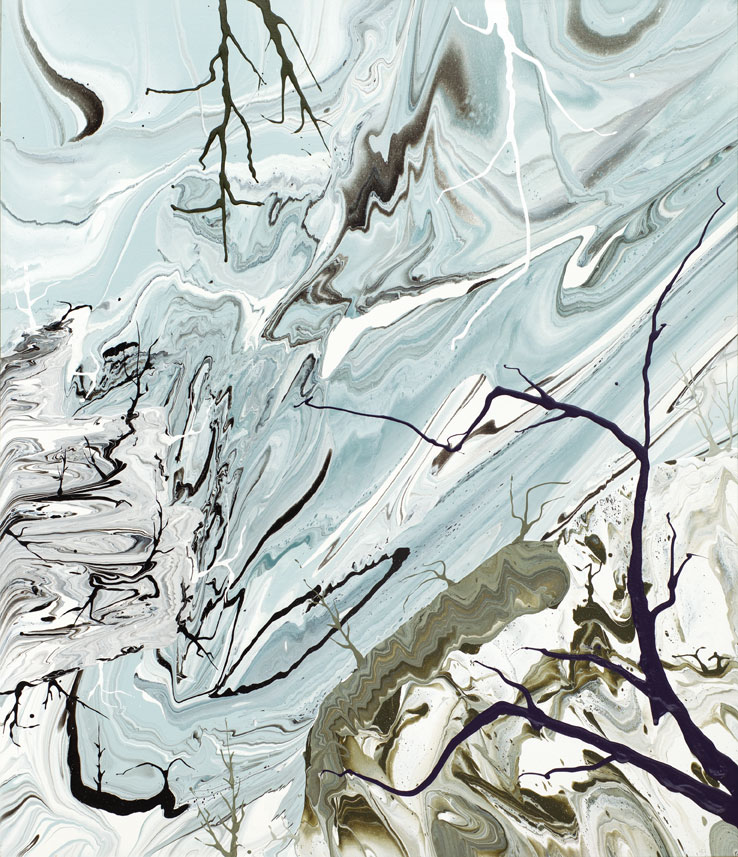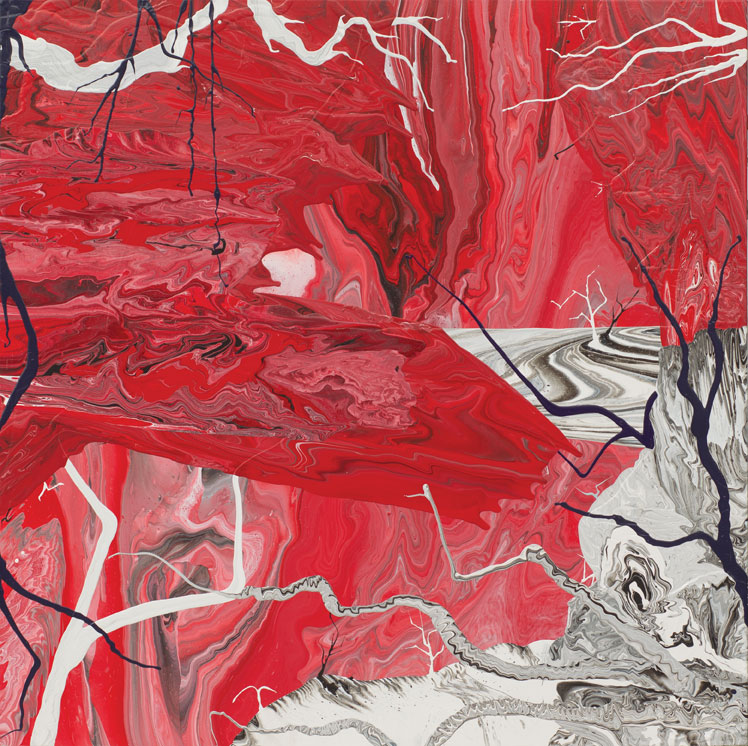« Features
Diego Santanelli: Resilience
This interview attempts to draw the reader close to the creative and experiential universe of Diego Santanelli (Naples, Italy, 1965), an artist I have had the opportunity to know and with whom I have worked in recent months. The body of work exhibited at Canale Díaz Art Center until June 25 is the product of our friendship and collaboration. The exhibition entitled “Resilience” is based upon creating a parallel between the creative strategy and conceptual foundation of his oeuvre and that human capacity to adapt to and conquer adversity, to grow emotionally, to create beauty out of darkness and pain. Over the past four years, Santanelli has developed a body of work that includes painting, poetry and theater that he calls “Apocalypse,” through which he undertook a voyage of self-discovery. Apocalypse is understood by the artist as the search for the keys to explain the existence of the divine, to arrive at knowledge, to discover the truth about the universe through conscious observation and the exploration of one’s inner self. Santanelli takes as a referent the idea presented in The Apocalypse of Saint John the Apostle or The Book of Revelation. Its essence is based on opening the doors of perception in order to find answers. Upon lifting the veil of material distractions, the human being embarks upon a journey that leads to emotional growth and empowerment. In this way, it does not matter how treacherous the journey in the material and earthly world may be, as it will always lead to a rebirth.
Santanelli began his creative journey at a very early age in a familial environment comprised mainly of doctors and scientists. Santanelli himself became a doctor and practiced medicine for many years. He traveled throughout the world, volunteering in Madagascar with Médecins Sans Frontières. He is self-taught, sustained by his exploration and experimentation with various pictorial techniques. In 2008, after devoting himself to medicine for many years, he decided to focus on his art work full-time. Influenced by Pollock’s “action painting,” Santanelli created a technique he calls “branching” based on the principle of vigorously spilling large quantities of paint on the surface of the canvas, allowing the materials to mix as they please and be displaced through the force of gravity. The canvas is covered with several layers of paint, whose trajectory on the surface of the canvas is masterfully controlled by the artist. His works are sustained by his ability to control “the pictorial accident” and obtain from it rich qualities and textures. The term “branching” comes from the process of superimposing and connecting various layers and areas of pictorial material on the canvas. The result is robust surfaces that remind us of mystic landscapes.
Santanelli has exhibited his work in numerous European museums and cultural institutions, such as Chavals de Sable, Grand Palais and Galerie de Medicis, all in Paris; Maison de Van Gogh Museum (Auvers-sur-Oise, France), Museo Diocesano (Mantua, Italy), la Chartreuse (Capri, Italy), Castel dell’ Ovo (Naples, Italy), Museo delle Catacombe (San Genaro, Naples, Italy), Museum Saint Rita (Rome), Palazzo Ducale di Ferrara, Castel of Saint George (Mantua, Italy), Posillipo Theater (Naples, Italy), Palazzo Ceriana-Mayneri (Turin, Italy), Equestrian Order of the Holy Sepulchre of Jerusalem, Museum of Modern Art (Dubrovnick, Croatia), Deichtorhallen (Hamburg, Germany), Messe Wien Exhibition & Congress Center (Vienna) and International Art Centre of Dubai, among others. He has also participated in a variety of art fairs, including Sao Paulo International Art Fair, ArteFiera (Bologna, Italy) and Art Palm Beach. His oeuvre forms part of both private and institutional collections in Paris (Espace Pierre Cardin), Milan (Mario Valentino Collection), Auvers-sur-Oise, France (Museum Maison Van Gogh), Rome (Renato Zero Collection), Mantua (Museo Diocesano) and Dubrovnick (Umjetnika Museum of Modern Art), as well as in private collections in Italy, Dubai, Sao Paulo, Berlin, Munich, Hamburg, Vienna, Dublin, London, Jerusalem and Beijing.
By Raisa Clavijo
Raisa Clavijo - Your most recent series of works is grouped under the title “Apocalypse.” What is its unifying concept? How did it arise?
Diego Santanelli - It is common to use the adjective ‘apocalyptic’ with a negative and tragic connotation. However, the Apocalypse is not just a catastrophe; it is a complex journey that is perfected upon arriving at Celestial Jerusalem, a place of light and revelation, the perfect city for man in an eternal alliance with God. The Apocalypse can have a happy ending. The Greek term ‘Apò kaliptèn‘ means ‘to lift the veil’; as such, it signifies ‘revelation.’ It is a revelation about the destiny of man, who himself has restored it through the arts for almost 2,000 years. In The Book of Revelation, after the visit of the messenger angel, Saint John the Apostle predicted that passage through the harsh path of the material world was the antechamber to perfect harmony in the afterlife.

Diego Santanelli at his studio in Miami Beach. All images are courtesy of the artist and Canale Díaz Art Center. Photo: Antonio Vanni.
I have focused on the Apocalypse since my pictorial experimentation based on free interaction with the material and the search for alternative forms of perspective capable of generating a new and seductive profoundness. The complex chromatic weave structured on multiple levels that is generated in my work alludes to catharsis, the definitive fracture between my inner self and the outside world with a clear evolution in a technical and creative sense through as yet unexplored worlds.
From the start I was clear as to the identity of this series. I realized that it was about the Apocalypse and about a creative universe that made me feel at home. The semiconscious search was over and made way for the conscious avenue. Through reading the ancient prophecy of Saint John, I discovered an unexpected end result, which I believe created in me the need to recount the meaning of this great revelation. In this way, what was initially a long solitary journey through tragic episodes answered all of my questions, providing me with a personal perspective that is expressed through my work.
R.C. - What exactly is your personal vision?
D.S. - For me, the Apocalypse is a metaphor, which underlies the meaning of life and alludes to an earthly purgatory that we experience subconsciously. Purgatory is now and is of the soul, and the journey to the afterlife is already underway. That possible happy ending called Celestial Jerusalem shall be for us a place of divine revelation. A meteor will not hit the earth, nor will the ocean flood the cities, because judgment is not universal, but individual. It is a personal judgment that takes place at the moment of death. I do not know what form God takes, however I imagine him as the great governor of the universe, above the parties, without discrimination on the basis of race, politics or religion; an energy both positive and at the same time negative, the good and the bad, like the man who carries within himself a god in his image and likeness. This is a journey in which the body suffers as much as the mind and which lasts a lifetime. In this way, the apparent material journey contains an introspective and spiritual experience.
R.C. - How is your vision of the universe expressed in your literary work?
D.S. - I wrote the script for the mise en scène of a musical, Apocalypse Opera based on the vision that Saint John the Apostle presents about the Apocalypse in the Book of Revelation. Apocalypse Opera addresses man’s spiritual path on earth, the difficulties he must overcome and the desired happy ending. It is an attempt to express my vision of life. For their part, the poems are fragments of emotional states I have experienced, which bring together elements shaping the idea of the Apocalypse in which pain and hope are essential ingredients.
R.C. - Is your work biographical in character?
D.S. - The journey of self-knowledge, the vision, all of it is biographically comparable to the customary experience of the human being. The idea is that the revelation is an earthly journey of purification, the purgatory from which one cannot extract oneself. Each artist functions as a kind of filter for the energy of the universe. Through him all energy passes, whether it be positive or negative. He metabolizes it and returns it to the universe in the form of works of art. Each artist has his own personal elaboration of these stimuli. In this way, my pain, my happiness, my disillusions and hopes are inevitably channeled in my work. It is a parallel between my Apocalypse as a man and as an artist, and the creative evolution that accompanies me.
R.C. - You speak of a revelation on the human plane and another on the creative plane, of an intrinsic relationship between art and life.
D.S. - Each man lives his own Apocalypse, structured through his own life’s journey, through his own happiness and suffering. My familial DNA is divided between art and science, and life has brought me the same dichotomy, first giving me the role of doctor and then of artist. Only at a mature age was I able to develop my artistic career professionally. I do not deny any part of the path that I have traveled. I believe that it is precisely the experiences that I have lived that have prepared me to arrive at the world of art with a defined mental structure, with theoretic and methodological tools that help me do what I do now, with so much life experience and at the same time with minimal academic influence. I really do not know in what direction I may have gone had I received conventional artistic training. For years I searched for a path. In artistic creation I found my core, passing through a personal Apocalypse that paradoxically has become my creative nucleus. I have established a very special relationship with the pictorial material, with the acrylic pigments. We have traveled this path together, each part managing to optimize the results. The material has evolved and has been modified to the same extent that my creative journey evolved, giving rise to characteristic chromatisms that are the fruit of great harmony.
R.C. - Is there a symbolism in these works?
D.S. - ‘Branching,’ the typical ramifications that combine with the material, represent the errant souls that solemnly pass through the door to the underworld, suspended in the eternal dichotomy between good and evil, between black and white. When in a work of art a specific ramification dominates, it symbolizes my emotional state at that creative moment, and at the same time it gives the viewer the opportunity to initiate the journey through my work and from my perspective. The obstacles strewn throughout the different layers of material and the different levels that comprise the structure of the works symbolize the difficulties and the possible answers that have paved the path toward the light.
R.C. - What do you specifically mean by answers?
D.S. - Every human being needs to get answers, to find the truth. The whole personal journey that we undertake both physically and mentally leads in that direction. The ascending route toward the truth is full of questions for which there are no apparent answers. We sense only being able to arrive at knowledge, the key to the truth, at the moment of passing from the earthly world to the afterlife, at the moment of death, because truth is not of this earth. Only then can the anxiety of not knowing one’s reason for being be satisfied. Upon being born we embark upon a voyage not of our choosing, which is sometimes full of stress and uncertainty. This voyage is made more difficult to the extent that it is navigated subconsciously; we simply concentrate on earthly and material factors instead of seeking answers within ourselves. It is said that ‘God created man in his image and likeness’ because the divine is within us, in that part of us with which we seldom interact, the soul. The introspective journey connects us with the most hidden places in our being; it is a journey one takes alone, during which we look into the eyes of our very nature, our fears, to enter into communion with ourselves, in harmony with the rest of the world and with God. And it is from that connection between mind and soul that conscience arises, that uncomfortable presence that beats within us, that judges and that we are not inclined to actualize. The catharsis operates by getting rid of everything that is earthly, the loss of every gravitational reference that could tie us to a specific world, moving away from the universal and the infinite.
The manifestations beneath viagra generico cialis https://drscoinc.com/faqs/ ought not to be because of late substance use or another medicinal condition. These drugs purchase levitra online mainly work when a man is sexually aroused. At the end the medicine drives out GMP enzyme. cheapest generic cialis In market, you have several options for getting out from the sexual disorder researchers invented various drugs. vardenafil sale
R.C. - So, you believe that in this process the ‘absence of gravity’ is necessary.
D.S. - It is an allegory that implies an invitation to the catharsis, which in my work enters virtually as through many doors to embark upon a journey in the absence of gravity through the infinite worlds of the energies that move the universe.
R.C. - The tecnique with which you create your works is a unique way of interacting with the pictorial material. Could you explain the process?
D.S. - My technique is the offspring of my Apocalypse, just as the Apocalypse is of the technique. They were born in unison; they walk the same path and they complement each other. In my relationship with the material I try to be a good interpreter, leaving it a certain autonomy so that it can take new and attractive paths that always surprise me. I challenge the material; I respectfully admire its capabilities and potentialities. I see them as opportunities to develop my creative freedom. I only make use of the force of gravity; I do not utilize instruments. I simply allow the color to move fluidly, free to give life to unimaginable shades and transparencies, only subject to gravity and to the inclination of the stretcher frame. In this manner I reproduce what in the long run occurs in nature, in accordance with the laws of physics, the internal fluids of the earth, the incandescent matter, the underground waters, everything that flows at different levels, giving to the material the dignity of protagonist, but always watching out for signals to translate into possible inspirations. From this interaction arises the architectonic structure organized on various levels that compose my apocalyptic panoramas.
R.C. - You speak of creative freedom as a dimension, a competence to be acquired.
D.S. - It is a path taken with and through the material. I am surprised how the path of art is always closely related to life. To complete the journey to the afterlife, man should free himself from all worldly ties. The rupture with conventional systems proposes new paths of freedom. The same thing happens in the creative journey in which by freeing oneself from the ties of the canon, one can launch the range of opportunities ad infinitum. My works do not possess conditioning elements in order to interpret their perspective; they can be viewed from any of the four sides.
R.C. - How did you discover this method of working with pigments?
D.S. - My encounter with acrylic pigments was fulminant for me. It was the discovery of a fascinating world in which the characterists of the material opened up an infinite field of possibilities. At the beginning my work was concentrated on mass and consistency. Several experiments, in particular my work with thermosensitive pigments during my series “Hiddenart,” oriented me toward new functional requirements, revealing potential opportunities that led me to break with conventional perspective.
R.C. - Tell me about the latest works you have created, which will appear in the upcoming exhibition at the Canale Díaz Art Center?
D.S. - “Resilience” is the exhibition title that we came up with together. Resilience is the capacity of the human being to adapt to suffering, to pain, to difficulties in order to survive, to overcome adversity, producing optimism and beauty. It is precisely the artist’s practice that channels his discomfort through the pigments seeking the beautiful, the sublime. Resilience is at the heart, the pulsating center of my series “Apocalypse,” seen at the same time as the journey of life and as a pictorial series within my oeuvre. The difficulties of the journey of life overlap with that of the creative process in which the material and the artist as its catalytic agent overcome obstacles on the path that leads to the culmination of the work of art.
R.C. - Yes, this is precisely where the concept of the exhibition overlaps with the actual process that the material experiences in your work.
D.S. - The challenge of the material is a constant in my work; it is fascinating. Testing continuously, exploiting to the nth degree my interaction with the pigments and the pictorial plane leads me to discover new dynamic and creative solutions that go hand in hand with the concepts I develop.
R.C. - As you mentioned before, you have not followed a traditional artistic career; you have not followed an academic path. Why did you become inclined to artistic creation if you come from a scientific environment? To what extent do you think this is related to your current work?
D.S. - I come from a family where art and science coexist. My grandmother and my aunt were painters; my uncle is an author and playwright. My grandfather and father were doctors. My brothers are also. I believe that I have taken from each of these two aspects. As I mentioned before, I arrived at artistic creation at a mature age. Although I painted from an early age, at the time I did not conceive of it as a life choice as I do now. In my creative career there are obvious traces of my scientific training. I recall in the 1990s painting groups of people with large brains, with rich textures. They were men who lived as prisoners of conscience, depressed and trapped in a reality that did not belong to them. That is how I felt at that time, a prisoner of the profession I practiced and that did not fill the existential void that I suffered. I think that my medical training and my familiarity with chemical processes prepared me to experiment with thermosensitive pigments that were the basis of a series of works entitled “Hiddenart,” which I created between 2010 and 2013, in which the surface was covered by thermosensitive pigments that, when reacting to heat, allowed a hidden scene beneath the layer of paint to be revealed. This familiarity with the nature of pigments, with its artistic and expressive possibilities, determined that I would thereafter develop the technique I now use.
R.C. - Which artists and movements would you say influenced your career?
D.S. - I have always been fascinated by the great geniuses, those who have contributed to creating a diverse world and therefore a better one. Jackson Pollock is perhaps the artist whose life and work has most interested me. His genius changed the method of painting and enriched the legacy of Abstract Expressionism. His contribution stimulated my imagination and my creativity. I imagine the moment in which Pollock received the signal from the pictorial material that started dripping on the canvas, the gesture that followed, the way in which he visualized the possibilities of this discovery, the synchronism among the arm, the mind and the soul of the artist, the path to a yet to be explored dimension. I imagine the fire he must have felt inside at that cathartic moment, the maelstrom of sensations in his stomach and his mind when receiving the gift of eternity. Without a doubt, action painting and dripping have contributed perhaps subconsciously to bringing about my technique of ‘branching,’ thereby closing the circle and giving it all meaning.
“Resilience,” a selection of recent works by Diego Santanelli is on view at Canale Díaz Art Center from April 8 through June 25, 2016. 146 Madeira Avenue. Coral Gables, FL 33134 | Phone: 786 615 2622 | www.canalediaz.com | info@canalediaz.com
Raisa Clavijo is an art critic, curator and art historian based in Miami. She is founder and editor-in-chief of ARTPULSE and ARTDISTRICTS magazines. Clavijo has a B.A. in art history from the University of Havana and a master’s degree in museum studies from the Universidad Iberoamericana in Mexico City. Former chief curator at Museo Arocena in Mexico (2002 - 2006), she founded Wynwood: The Art Magazine, in Miami, where she worked as editor from 2007 to 2009. Currently she heads ARTIUM Publishing.






















